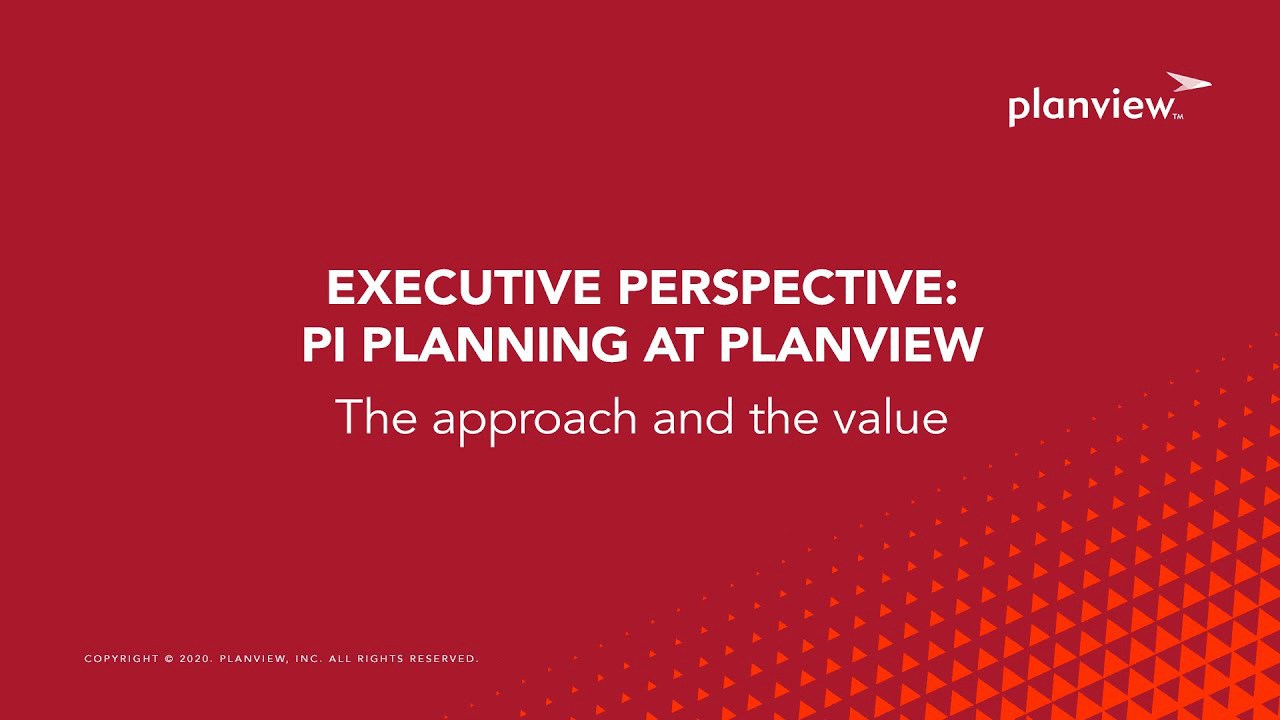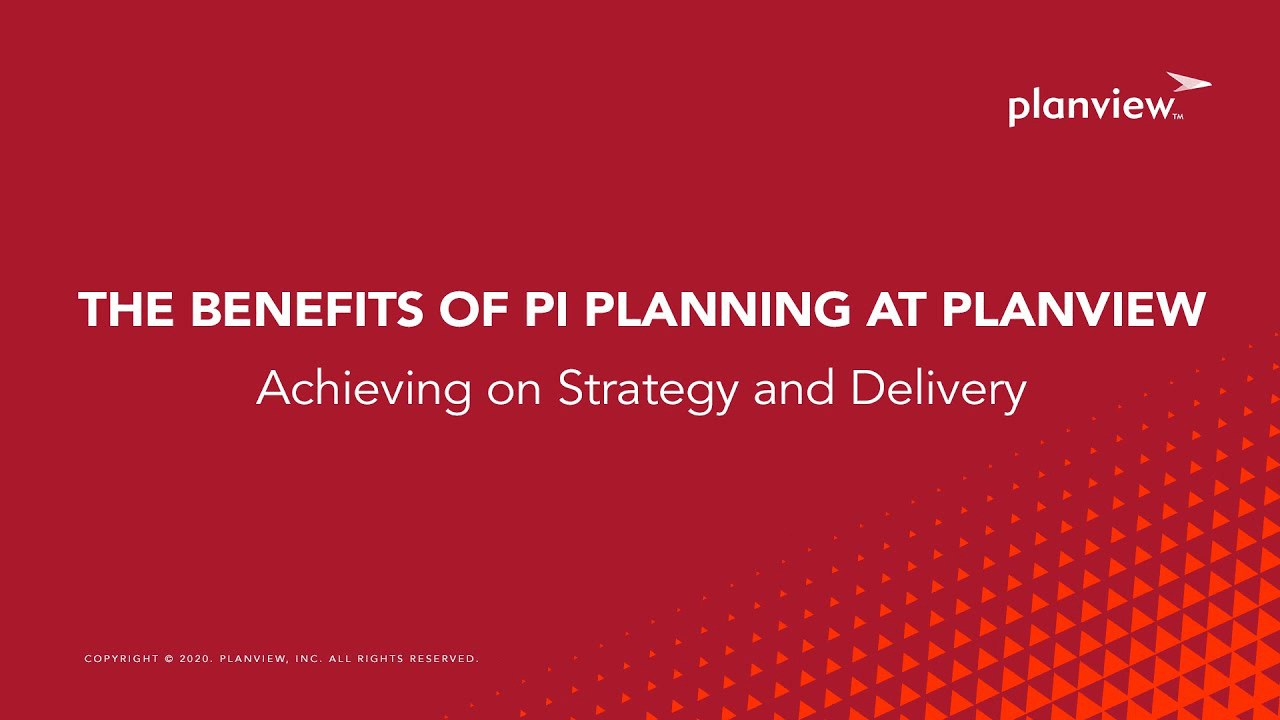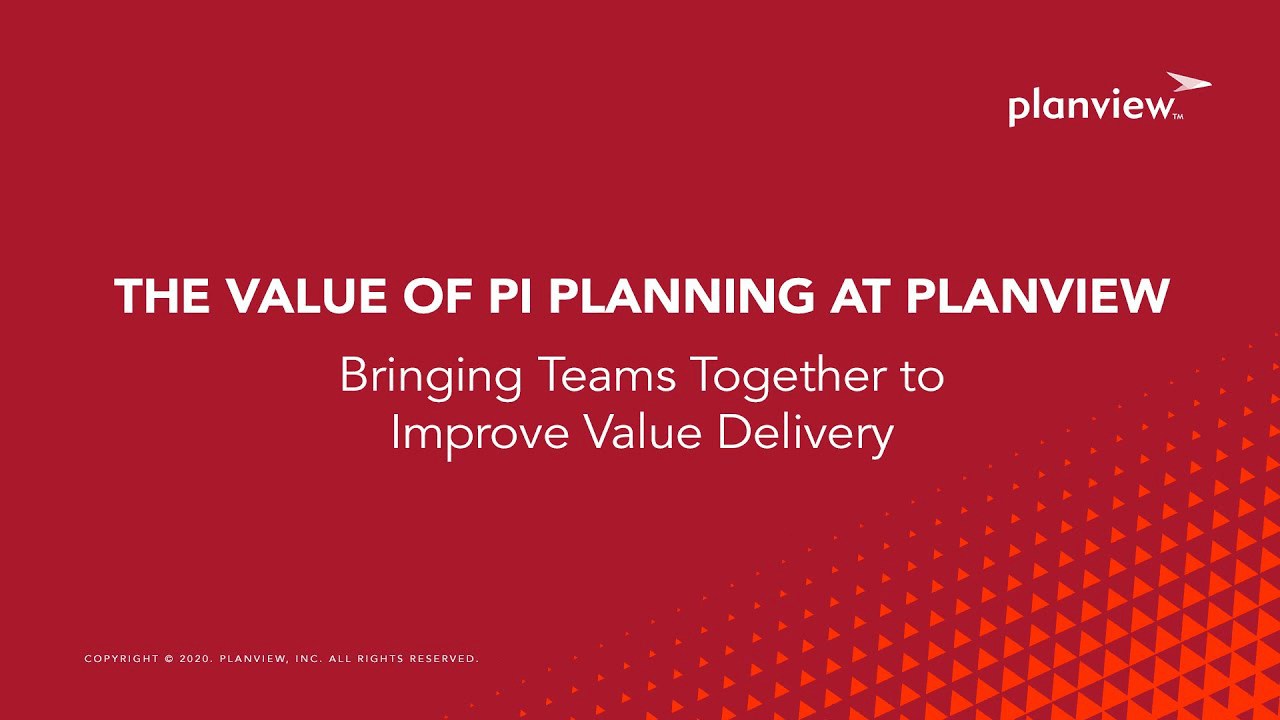Who Reviews the Top Capabilities for the Upcoming Pi
Program Increment (PI) Planning is the heartbeat of the Agile Release Railroad train. Or, perhaps more accurately, it lays downward the tracks for the train to brand sure all the train cars go in the same management. Large-scale Safety development is a finely tuned machine that must be maintained.


Acquire how to measure at the teams of teams level.
The PI Planning event is two days of focused planning with all the teams, stakeholders, and product owners/managers in ane place to review the plan excess and determine the management of the business. This result typically happens every eight to 12 weeks and can be a meaning challenge for large teams that are spread out across the country or even the world.
We are here to explore PI Planning, its importance to Prophylactic evolution, and some of the challenges of PI planning with multi-locational teams. We can explore some of the tools and processes that teams utilize to ensure anybody is focused on planning and that the teams walk away from the result feeling confident in the direction the business concern is going and what they need to help information technology become there.
We are hither to explore PI Planning, its importance to SAFe development, and some of the challenges of PI planning with multi-locational teams. Nosotros can explore some of the tools and processes that teams utilise to ensure everyone is focused on planning and that the teams walk away from the event feeling confident in the management the concern is going and what they need to help it get in that location.
Why Is PI Planning Important?

Acquire how to build stable teams and teams of teams.
Scaled Active Framework (Condom) helps development teams tackle the challenges of analogous multiple teams, processes, and programs to evangelize a unified product.
The Agile Release Train (ART) is the cadre of all the teams working together for a common goal. In very large enterprises, there may be 2 or more trains working together, and that is why every viii to 12 weeks the teams need to step back and make certain they are still working toward the concern goals and the overall vision.
PI Planning is scheduled at the beginning of each Plan Increment and later on the Inspect & Adapt Iteration. Although some companies may showtime the PI Planning event with the Inspect & Accommodate meeting, that is not the focus of this article. The outcomes of the Inspect & Adjust event should be a part of the content of the PI Planning going forrard. These items become action items for the next Programme Iteration.
Steps of PI Planning
Preparation
3 areas of training for PI planning are:
- Organizational Readiness – Arrangements must be made so that all the stakeholders and leaders involved in the program will exist bachelor. This works best if the PI planning meetings are scheduled far in advance. Almost large companies will make this a quarterly coming together that everyone tin can count on. It tin be scheduled for the terminate of the previous quarter so that everything is in place for the beginning of the next quarter.
- Content Readiness – The programme purpose and vision demand to be well in mitt for the start of the planning. Business stakeholders and programs leaders are the best to convey this to the teams at the start of solar day one.
- Facility Readiness – A large room can be one of the best ways to brand sure all the teams tin move around and ask questions of the other teams. A good dominion of thumb can be a room twice the size of what would be needed for the number of people. For example, if you have 75 team members, you lot should take a room large enough for 150. Walls keep people from moving and talking. For remote team members, there should be at least one calculator for video conference per tabular array. (Make certain remote team members know which speaker/computer is with which squad or apply applications such as Zoom that allow for breakout rooms.)
Standard Calendar
There are many sources for instance agendas for the PI Planning issue. Depending on your system, you lot may want to add motivational speakers, take time to recognize the accomplishments of the last PI, or just allow for some time for water ice breaking games so teams tin can get to know each other. These tin all be useful in teambuilding and adding a social element to the event. Hither is an example agenda from ScaledAgileFramework.com. It outlines the more disquisitional of steps that are needed for a successful effect.
Twenty-four hours One Calendar
- Concern Context – This is an update given by a member of upper level management or a business concern possessor giving the teams perspective on how the business is doing and how well they are keeping up with the market place and the consumer needs.
- Product/Solutions Vision – Product management volition present the vision for the business organisation for the upcoming PI. This volition often include the acme ten features as determined by business management that will assist run across these goals.
- Architecture Vision & Development Practices – Systems Architect or IT department volition outline the systems and architecture vision for improvements to the infrastructure that will help to improve the time to market and may impact development during the coming PI. A senior development manager may outline any Active-related changes in procedure that will improve velocity and communication.
- Planning Context & Lunch – The Release Railroad train Engineer (RTE) outlines how the PI planning process will work and what is expected from the teams and the overall meeting. They will often outline what the expected outcomes are for the meeting and answer any questions that the teams may have almost the procedure.
- Team Breakouts – Teams will get together around the boards (either analog or digital) to estimate their velocity for each iteration and await over their backlogs and what will need to be brought forrard to support the features outlined in the vision. Teams will submit their draft plans for all the teams to review and give feedback. They will need to identify risks and dependencies. This is the time to call out where their iterations will demand to connect with other teams and even other ARTs. Communication between teams is encouraged.
- Typhoon Plan Review – This is a time-boxed meeting where the teams present their draft plans so that business organization owners, production owners, stakeholders and other teams can give feedback. Teams can use the feedback to refine their drafts before the management review or outline potential bug to exist solved by management in the review.
- Direction Review and Trouble Solving – In most cases, the draft plans will bring upwards issues with architecture, scope, and people and resources constraints. These issues can sometimes just exist solved past management renegotiating scope and possible features. This meeting is organized by the RTE (Release Train Engineer) and the stakeholders and business organisation owner must come out of the meeting with a new fix of priorities or features for the teams to use the side by side day.
Day Two Agenda
- Programme Adjustments – The day begins with any adjustments or decisions that were made by management and stakeholders in the trouble-solving meeting. These are presented to the teams and can sometimes result in a new acme 10. These will exist posted on the programme lath, so all the teams tin can see and reorganize.
- Team Breakouts – The teams have the adjustments dorsum to their planning and come back with their PI objectives for the program board. Business concern owners volition assign values to each of the objectives to rank them for implementation. Teams will then have a better idea where their objective will fit in the coming iterations.
- Final Plan Review and Lunch – During this meeting, each team brings their plans to the front and presents them. At the end of the presentation, they list out the risks and dependencies. This is not the time to try to solve these bug. The plans are posted so that the teams can see them all together and become feedback.
- Plan Risks – In the prior step, all the teams listed out their risks and dependencies. Now that all the objectives are posted, the teams can accost each hazard in turn and determine if they can be overcome. The issues are placed in i of these categories:
- Resolved – After discussion, the teams agree that the consequence is no longer a business.
- Owned – Someone on the railroad train takes ownership of the particular to piece of work on solving the result at a later fourth dimension.
- Accepted – Some risks are but facts or potential problems that must be understood and accepted.
- Mitigated – Teams will work together on a plan to reduce the touch on of a risk particular. The workaround or solution is documented and then that it can be recalled when the time comes.
- Confidence Vote – Once all the risks and objectives take been outlined and discussed, the teams will vote on their confidence that the objective tin be accomplished in the coming PI. This is a v-finger vote. The team members will hold up their hands with one to 5 fingers. Annihilation less than a three-finger vote will demand to be addressed. The team member that has a problem with an objective volition need to explain the result so that information technology can be addressed past the teams. If the problem is satisfied, the objective is voted on over again to reach a confidence vote for the coming PI.
- Retrospective – At the very end of the meeting the RTE will hold a modest retrospective on the PI Planning outcome to gather feedback on what went well for the event and what needs to be changed or improved for the next event.
- SMART objectives that are created past each team
- Program Managers will utilise these to update the Program Board
- Accustomed Features
- New Feature Delivery Dates
- Characteristic dependencies (betwixt teams and other ARTs)
- Milestones
PI Outputs
Committed PI Objectives
Plan Board
Business organisation Benefits of PI Planning

PI planning delivers many business benefits, including:
- Establishing face-to-face communication across all team members and stakeholders – Information technology is extremely of import to have anybody focused on the upshot.
- Building the social network the Fine art depends upon – Even for remote squad members, ice breakers and squad-building games assistance build trust and comfort.
- Aligning development to business goals with the business context, Vision, and Team and Plan PI objectives – The event brings anybody together and then that they tin sympathise the company vision and feel like role of the process.
- Identifying dependencies and fostering cantankerous-squad and cross-ART collaboration – In many large companies, people finally get to put a face with a proper name that they have been emailing for months. When addressing problems, risk, and dependencies, it is important that anybody feels comfortable reaching out for help and working out how the teams can work together.
- Providing the opportunity for "merely the right amount" of architecture and Lean User Experience (UX) guidance – Unlike teams bring dissimilar perspectives to tackling a problem.
- Matching demand to capacity, eliminating excess Work in Process (WIP) – Squad members are together to ask all the right questions and tie up loose ends.
- Fast decision making – When anybody is together, there is no waiting for someone to get back to y'all or wondering if they got your e-mail. Discussions, debates, and decisions happen in a matter of minutes or hours instead of days or weeks.
Remote Challenges of PI Planning

Remote Teams demand to exist engaged and accountable
The Active Manifesto states, "The most efficient and effective method of conveying information to and within a development team is a face up-to-face conversation."
The challenge of keeping the remote team members engaged and focused on the planning tasks can exist tough. There are a number of video conferencing services on the market that permit teams to video briefing private members just to also have cameras focused on local teams. This makes it possible for anybody to come across and interact with each other in the aforementioned fashion as if they were all sitting together in a meeting room. Applications such as Zoom offering team video conferencing but also breakout sessions for PI planning. Remote members should exist required to continue their cameras on so that everyone tin run into each other. They should likewise plan to be in a quiet place then that there are no distractions and they tin focus and participate in the planning sessions.
Real-fourth dimension digital programme boards for PI Planning
LeanKit by Planview is a solution that has templates for some of the well-nigh common Safe development boards. These can exist online during planning sessions to allow teams to piece of work digitally in real time for all remote team members to share.
- SAFe lath templates include: Objectives, Portfolio, Programme, Risks, Teams and Value Boards
- Program boards can bring together all of the teams' ideas during the meeting. The meridian 10 features can exist loaded in the Characteristic Funnel to the left and moved into Iterations or even moved to the next PI if time and resources volition not permit the feature during the current PI.
- Risk boards can help the ART to work through the risks and dependencies that the teams bring to the Program lath. Using the Risk lath allows anybody at the meeting to focus on the risks and how to best tackle them. This lath uses the categories for the Program risks that are outlined by SAFe 4.5.
- Team Boards tin can help Teams in their breakout sessions so that all the squad members tin can see and add to the board no matter where they are. Clean-cut stories tin can exist loaded in the story excess and moved to PI integration as the squad works on their objectives.
Sharing the brainstorming boards and chats
If local teams still want to use analog planning games, teams can assign ane member to work with a remote team member to create their local contributions. For instance, if Jenny is remote, she tin can utilise chat or other tools to transport her teammate John an idea for the board. That manner, she can still contribute with the team planning breakout sessions. I team member tin can also exist charged with updating any online digital boards so that ideas are ready to share with the remainder of the meeting at the terminate of the breakout session.
Social interaction
Teams should exist encouraged to do squad-building games and water ice breakers early on in the meeting or during the breakout sessions so that team members can go to know ane some other. These games tin can hands include the remote team members on video conferencing. Ice breakers tin can include "little known facts nigh me," sharing pictures from a holiday, or an event such as "show and tell." Remote team members should ever be required to have video. Seeing each other builds trust betwixt members when they tin can see body language and facial features.
Prophylactic v.0 and Business Agility
The latest version of Safety® five.0 expands the framework beyond business operations to embrace full business agility.
"Concern agility happens when the entire arrangement – concern and tech leaders, compliance, development, finance, legal, marketing, operations, sales, security, support – uses Lean and Agile practices to continually and proactively deliver innovative concern solutions faster than the competition." Scaled Agile, Inc.
With the addition of concern agility to the framework, PI Planning (and the pre- and mail-PI Planning ceremonies) becomes even more than valuable to the business organization. As a business expands Agile, expanding PI Planning to multiple events to include all parts of the organization, connecting the ARTs, and the piece of work to the overall business organisation goals, is tricky. This is where leadership comes in. There must be buy-in from the leadership at the acme and implementing a PI Planning-like event for leadership (think Quarterly Steering) to inform the business concern may be necessary.
It'south in a Quarterly Steering/Planning Meeting (oft a day or two) that leadership lays out the goals and objectives for all parts of the business organization, based on current state and time to come strategies. In Quarterly Steering, the business organization tin show the need for diverse changes or brand requests of the value streams to help deliver against those goals/objectives. This data is then taken to corresponding PI Planning events, to inform their planning appropriately.
To practice this well, digital tools are fifty-fifty more crucial in these larger solutions and the visual nature of Kanban is growing as the front-runner for business concern teams. Having one source of truth for the status and priorities of the business organisation can salve a great deal of confusion and frustration and keep the organization aligned from bottom to meridian and across the whole.
Determination
In the 1000 scheme of today's development earth, teams are condign more than and more than distributed. While many of the team members may be onsite and tin can attend the PI Planning meeting, at that place may be unabridged teams that cannot. For Condom to evolve, consideration and thought will need to be given to how all-time to include the valuable input of these remote teams.
As online tools emerge, RTEs and business owners need to retrieve exterior the box and plan how to coordinate and railroad train teams to use these tools for collaboration. The more teams use the tools on a day-to-twenty-four hour period footing, the easier it volition be to apply them for big events such as PI Planning and other iteration meetings and ceremonies. Even teams working within the same edifice tin can benefit from having a digital source of information and a single source of truth within the system for answers to questions. It tin as well serve to let team members to know their stakeholders and production managers so that the right people can answer the right questions at the right time.
Teams that rising to this claiming will have the largest pool of skills and talent for their team members and the greatest adventure of success in this fast-paced market.
Source: https://www.planview.com/resources/guide/scaled-agile-framework-how-technology-enables-agility/program-increment-planning/
0 Response to "Who Reviews the Top Capabilities for the Upcoming Pi"
Post a Comment